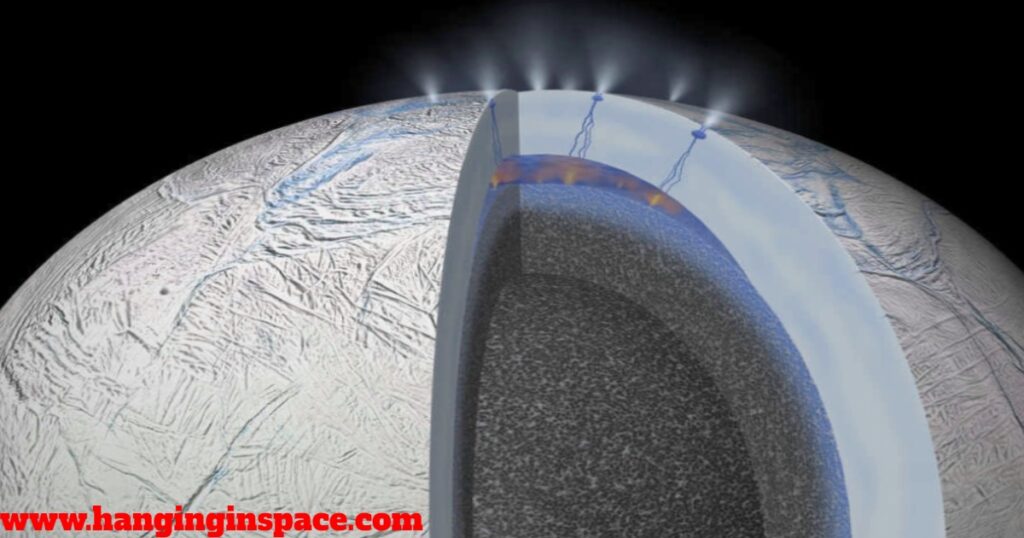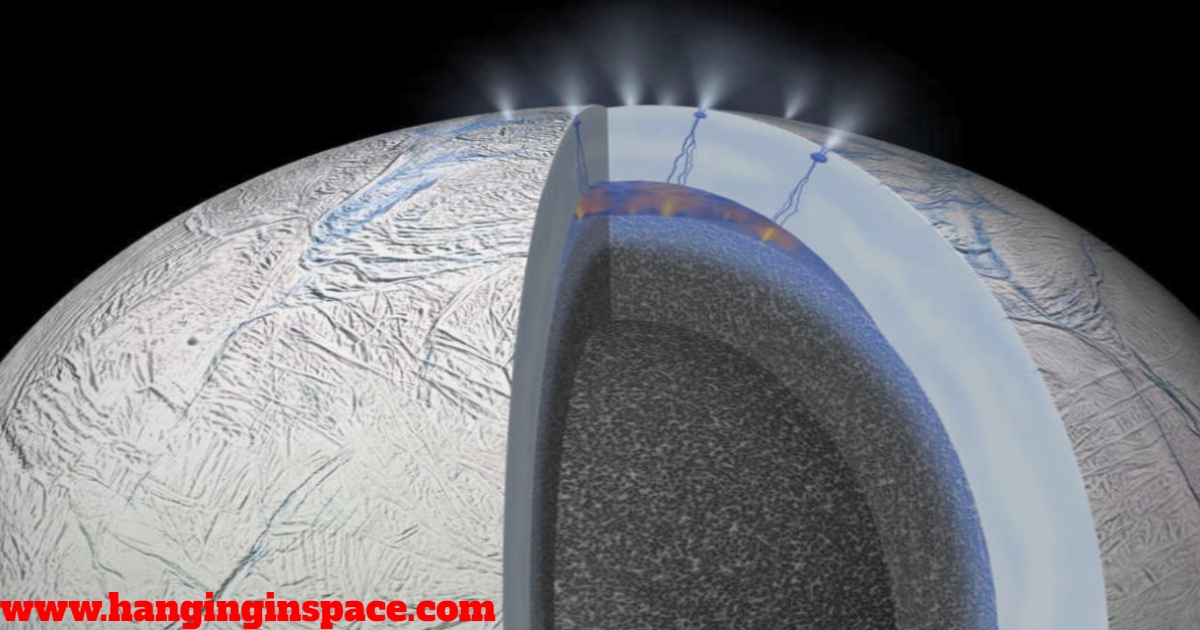Enceladus – Moon of Saturn
The sixth-largest moon of Saturn, Enceladus, is one of the solar system’s most promising and potential places to host life. It travels around Saturn in its E-ring. Beneath the surface of the Enceladus is a worldwide ocean of liquid, salty water. Being primarily coated in clean, new ice, it is one of the Solar System’s most reflecting bodies.
According to NASA, it continuously shoots a mixture of water and basic organic compounds into space at a speed of about 800 miles per hour (400 meters per second), creating massive plumes that reach hundreds of miles into space. Some material escapes and feeds Saturn’s massive E ring, while the rest returns to the cold globe.

Enceladus orbits Saturn in a prograde, almost circular orbit with a mean distance of 238,020 km (147,899 miles), with a diameter of around 500 km (310 miles). Given that its average density is only 60% higher than that of water, there must be a sizable amount of non-ice stuff inside of it.
Its surface is mainly smooth but has some cratered and grooved plains, reflecting almost all the light that strikes it. It takes Enceladus only about 32.9 hours to complete one full orbit around Saturn. Enceladus is tidally locked with Saturn, similar to the Moon and Earth. Because of tidal locking, Enceladus’s rotation period (how long it takes to spin on its axis) is exactly the same as its orbital period.
NASA claims that the substances that Enceladus spews forth include carbon dioxide, water vapor, methane, and maybe nitrogen gas, ammonia, and carbon monoxide. Enceladus may have hydrothermal vents because it also includes salts and nanograins of silica, a mineral that only occurs on Earth when rock and extremely hot water mix.
Enceladus is the solar system‘s brightest object because of its highly reflecting ice surface. According to NASA, the surface of the planet is not uniform, with some regions having nearly no craters and others having numerous craters. According to scientists, Enceladus’ surface renewal was made possible by very recent geological processes.
It is believed that Enceladus, like other frozen moons orbiting gas giants, relies on tidal heating to preserve a liquid subsurface ocean. Because of its varying distances from Saturn, Enceladus experiences strong tides and friction from Saturn’s gravity, which is then converted to heat.
Enceladus has a surface gravity of approximately 0.114 meters per second squared (m/s²). This is roughly 1/100th of the surface gravity on Earth (which is about 9.81 m/s²). The escape velocity of Enceladus is approximately 240 meters per second (m/s), which is equivalent to 536 miles per hour (mph).
Based on current studies, the majority of the chemical elements required for life are probably present in Enceladus’ subterranean ocean. The Cassini spacecraft obtained the first close-up photos of the moon and gathered comprehensive data on its chemical composition.
The Voyager 1 spacecraft and Voyager 2 spacecraft collected some of the first meaningful data on Enceladus. Future trips to Enceladus are planned, and they would investigate the moon’s chemistry, geology, and potential for supporting life.

When and Who Discovered Enceladus?
On August 28, 1789, British astronomer Sir William Herschel made the discovery of Enceladus. On September 17, 1789, many weeks later, he found another moon, Mimas.
Herschel most likely used his 40-foot telescope, the largest in the world at the time, to discover both moons. The first woman in England to be paid as an astronomer was Herschel’s sister, Caroline Herschel, who contributed to the telescope’s construction in exchange for a meager stipend.
What is the Estimated Age of Enceladus?
Research published in April 2019 suggests that Enceladus is about a billion years old. According to Marc Neveu, a NASA research scientist and study author, it might make it the ideal age to support life.
However since the study relied only on the output of a single computer simulation, it is difficult to determine the precise age of Enceladus. Enceladus and a few of Saturn’s other moons may have originated as recently as 100 million years ago, according to an earlier study.
What is the Size of Enceladus?
Enceladus is one of Saturn’s largest moons, weighing in at roughly 315 miles (500 kilometers), or roughly the width of the state of Arizona, despite the planet having 145 confirmed moons in total. It is therefore only roughly one-seventh the size of the moon of Earth.
Enceladus is losing mass through the ocean stuff that its geysers expel at a rate of around 440 pounds (200 kilograms) every second. However, data indicates that decreased geyser activity may be the reason behind the lowering of Enceladus’ mass loss rate.
Enceladus’ radius is 252.1 kilometers (156.6 miles). Enceladus’ diameter is 504.2 kilometers (313.2 miles). Enceladus’ circumference is 1,584.4 kilometers (984.8 miles).
What is the Temperature of Enceladus?
Enceladus is the brightest white planet known to exist in our solar system, reflecting up to 90% of light striking its icy surface. With an average temperature of -330 degrees Fahrenheit (-201 degrees Celsius), it is likewise quite cold.
The south pole of Enceladus is the warmest, and scientists believe that this is where the heat from the moon’s interior is escaping, causing the moon to spew water vapor into space through its “tiger stripes,” which are wide fissures in the surface ice that crisscross the moon. Even the smallest regions hardest hit by the heat, according to the Cassini mission, were still a cool -261 degrees Fahrenheit (-163 degrees Celsius).
What does the Atmosphere of Enceladus consist of?
The scientific term for the extremely thin and erratic atmosphere on Enceladus is its exosphere. Water vapor makes up the majority of the exosphere on Enceladus, and it is predominantly produced by plume activity close to the South Pole. Water ice jets that escape from the moon’s interior feed these plumes.
What is Enceladus’ Distance from Saturn?
About 148,000 miles away, Enceladus circles Saturn while circling the moons Tethys and Mimas. It takes roughly thirty-three hours to complete one orbit. Similar to our own moon, Enceladus and Saturn are tidally locked, which means that the same side of the moon is constantly facing the planet.
Additionally, it has an orbital resonance, in which Enceladus and Dione, one of Saturn’s largest moons, align themselves periodically due to their gravitational attraction. In the time it takes Enceladus to complete two orbits of Saturn, Dione completes one orbit.
Dione’s gravity causes Enceladus’ orbit to lengthen, which in turn causes the smaller moon’s tidal heating and, potentially, the continuation of its liquid subsurface ocean.

What are the Geysers of Enceladus?
Throughout the moon’s interaction with its home planet, at least 101 geysers have released frozen material into space from beneath the surface. Over the length of Enceladus’ elliptical 1.37-Earth-day orbit around Saturn, gravitational forces cause the cracks to open and close.
When the moon is farthest from Saturn, the geysers are at their greatest, yet the gas emission does not rise during that phase. This hints that something intriguing is happening with its internal plumbing, which runs opposed to what scientists had previously believed.
Additionally, since the Cassini mission started monitoring Enceladus’ geysers in 2015, at least several of them have significantly reduced in output, while the precise cause is still unknown.
Ammonia in the material streaming off Enceladus may work as antifreeze to prevent water beneath the surface from freezing, even though the frigid moon should be too cold for liquid water. Neither does the acidity found in Enceladus’ plumes rule out life.
The diameter of Enceladus is merely 1/77th that of the moon of Earth. It is Saturn’s sixth-biggest and largest moon. It takes on the shape of an oblate spheroid, similar to most spherical bodies, and as it spins, the force of gravity causes it to bulge out somewhat around its equator.
The fact that Enceladus possesses an atmosphere, which is more prevalent in its warmer south pole, astonished scientists because the moon is so small and only experiences a slight gravitational pull at its surface.
Conclusion:
In conclusion, research on Enceladus is crucial. There is evidence that suggests liquid water beneath the surface may come in contact with rock inside the moon, which is exciting because we believe comparable conditions led to the emergence of life on Earth a long time ago.
We just do not know how habitable Enceladus may be as we do not know how long these kinds of conditions have existed on the planet or if the underlying water can sustain a habitable environment. But most of the mysteries will be resolved in the future by space exploration.
